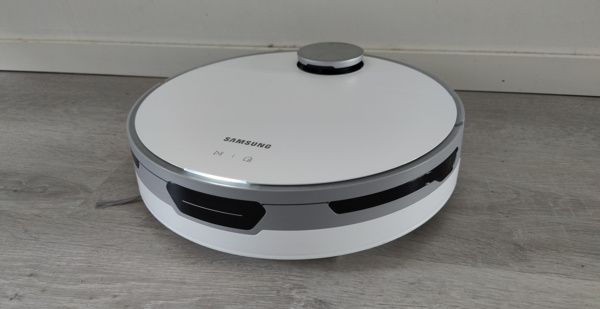
We were given one of Samsung's new generation of robotic vacuum cleaners for a review: the new Samsung Jet Bot 80+, which is also sold under the name Samsung Jet Bot+.
It is a robot vacuum cleaner with a self-emptying dust container, which was released in the European market in 2021. Before this current series, Samsung was out of the robot vacuum business for years - bot now the company has decided to make a return to the market.
As usual, we put the robot to a work for more than three months. During our test period, the vacuum cleaner took care of cleaning the floor surfaces of two different apartments, as the only tool used for cleaning the floors.
Important to our test (as usual) is how suitable the product is for pet owners. Therefore, the test appropriately included everyday experience with how the Robo copes with pet hair and other problems that pets bring with them to the home.
The selling price for this product is around €500 in Finland, so it is placed in a difficult price segment in that sense: in the 500 euro range, top products are also available from competitors that manufacture robot vacuum cleaners, and they have more of a reputation in the market than Samsung.
The Samsung Jet Bot 80+ is delivered in a rather huge sales package typical of self-emptying robot vacuum cleaners.
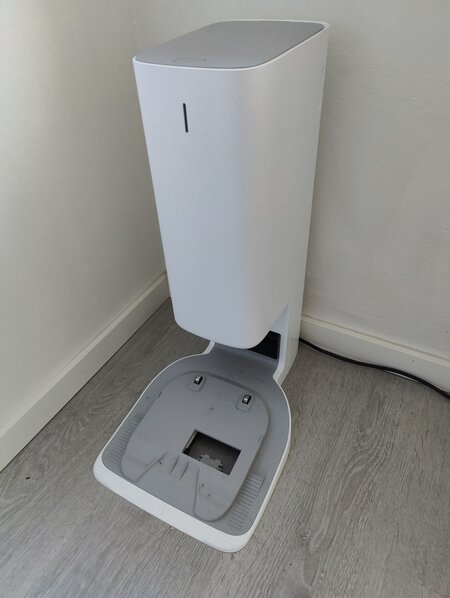
The inside of the package reveals a shiny white robotic vacuum cleaner with a rather traditional design and a charging station that looks like a futuristic coffee maker. The charging station contains a mechanism with which the actual robot vacuum can empty its internal dust container into the larger dust container located in the charging dock.
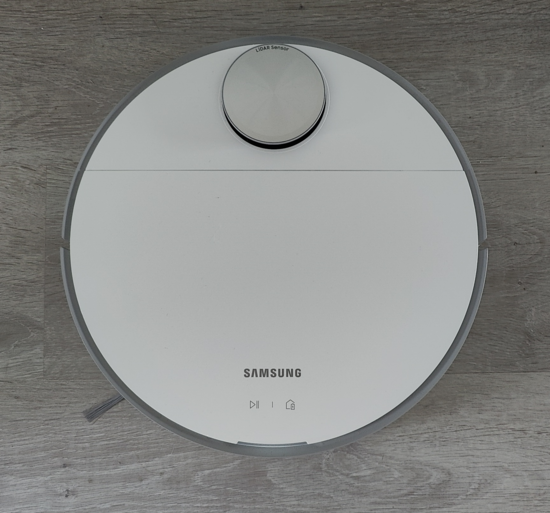
The robot itself is clear and simple: a disc with two tactile buttons on top.
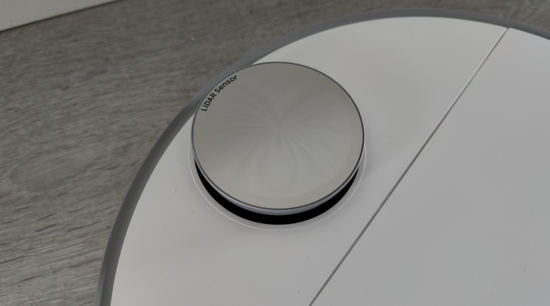
The most clearly distinguishing detail in the appearance is the lidar radar of the Samsung Jet Bot 80+, left in chrome, which rises about a centimeter above the rest of the body.
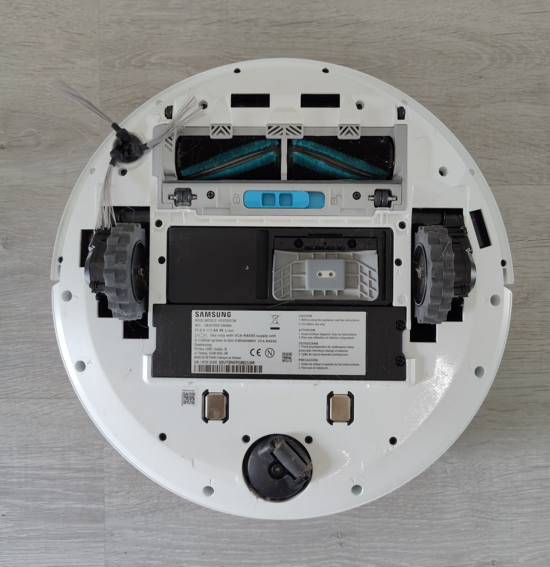
Samsung's interesting solution is revealed below: instead of brush rollers or silicone rollers, Samsung relies on a single, soft cleaning roller that resembles a rough sponge. At this point it should be mentioned that Jet Bot is not a robot mop.
The robot's side brush is commendably large and clearly protrudes, which promises good things when it comes to cleaning corners and walls.
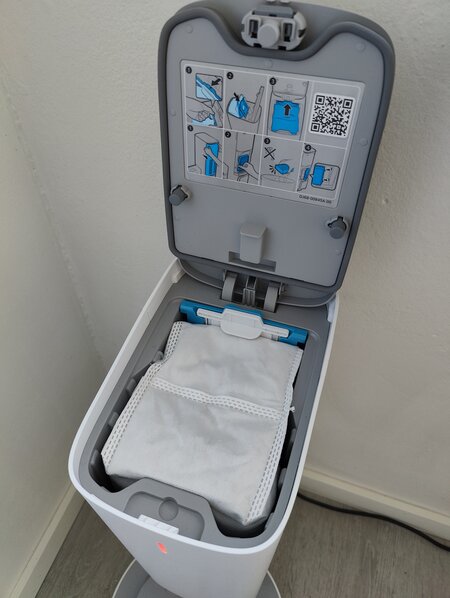
The tower of the charging dock features a container that opens with a clever mechanism, inside of which there is space for Samsung's own dust bags. The dust bags are a little disappointing, but for some reason almost all manufacturers prefer dust bags in the docks of self-cleaning robots. However, a large container that can be knocked empty would be a more ecologically sound choice.
The Samsung Jet Bot 80+ is very clearly a "connected" device, meaning that in practice the full use of the vacuum cleaner requires that there is WiFi and a smartphone at home. All adjustment of the robot and general control takes place through the smartphone application.
Using the robot is very clear in itself: let's find a suitable place for it, from where the vacuum cleaner can move freely in all situations throughout the apartment. Place the Clean Station charging dock in the selected location and start charging the robot.
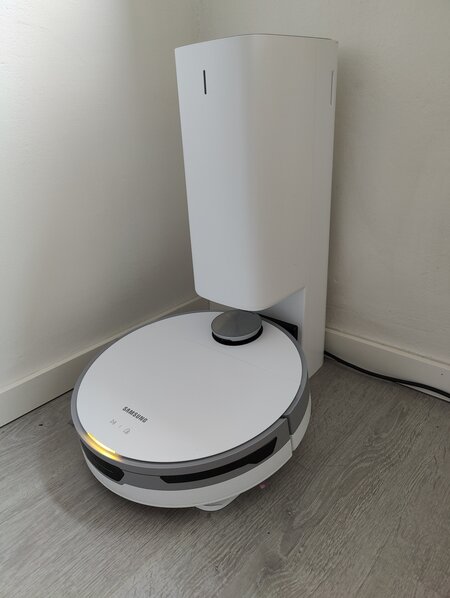
After that, install the Samsung SmartThings application and connect the robot to the application. Finally, let the robot do a mapping tour of the apartment, during which the robot builds a floor plan of the apartment with the continuation in mind.
Samsung's SmartThings application is in many ways an excellent package, but can also be confusing. The application is not only intended for controlling the robot vacuum cleaner, rather the application is the common "home" of all Samsung smart devices, through which all Samsung devices are controlled.
The starting point is clever in itself, but if the robot vacuum cleaner is the only Samsung smart device in the home, the application is extremely versatile. In addition, a big minus comes from the fact that Samsung SmartThings is only partially translated - the functions related to the robot vacuum are left completely untranslated - even though the main application itself is reasonably well translated.
When you dig into the settings and functions of the robot vacuum cleaner in the application, that side is relatively clearly designed. Roughly, you could say that if Roomba's application is the clearest on the market and Xiaomi's / Roborock's alternative is the most confusing, Samsung is somewhere in between.
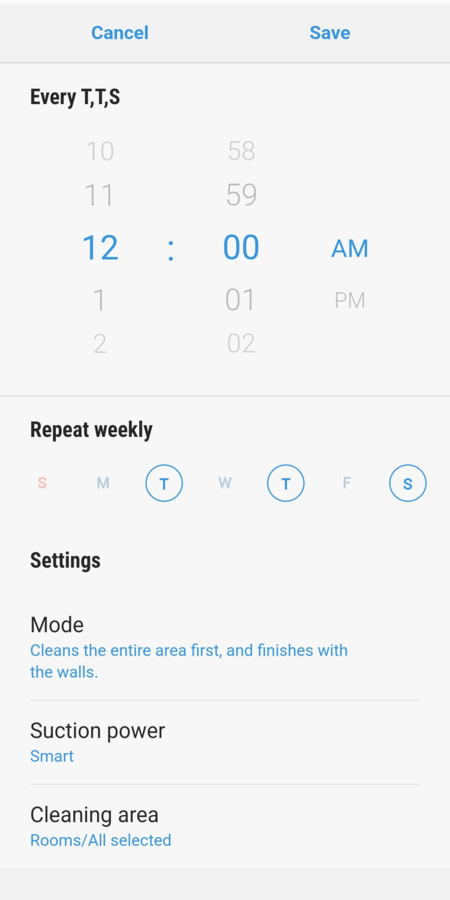
However, the robot can be controlled very well through the application. Creating schedules is simple, but also the construction of complex logical functions focused on the smart home can be done after a little thought.
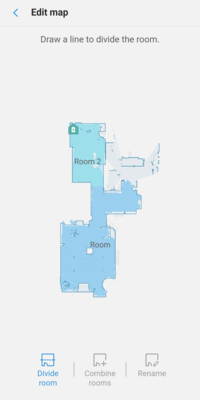
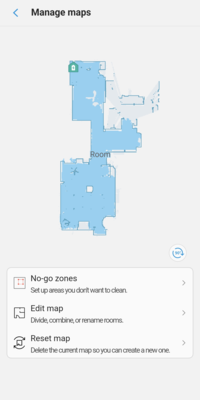
When it comes to maps, Samsung is right at the top of the robot vacuum cleaners: editing maps, dividing into rooms, creating prohibited areas and building separate cleaning areas are all very easy.
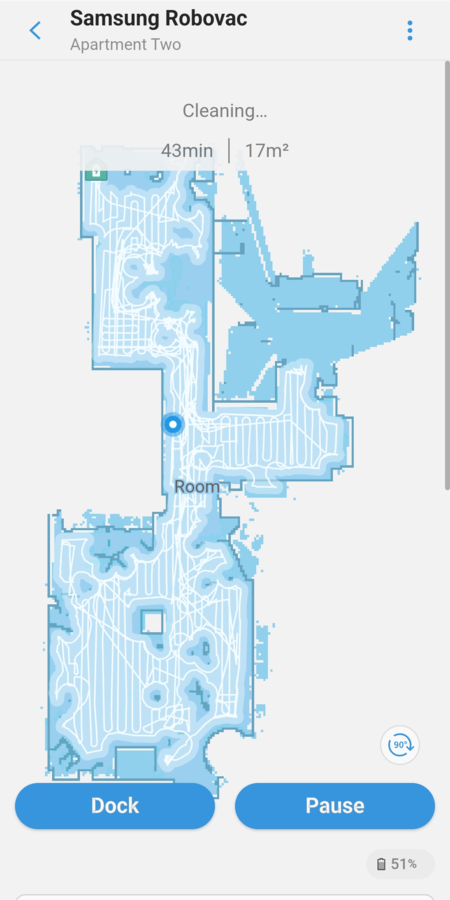
Also, a real-time image of where the robot is cleaning in the apartment at that moment is a handy addition. From the same view, you can also get an idea of which part of the apartment the robot has already managed to clean.
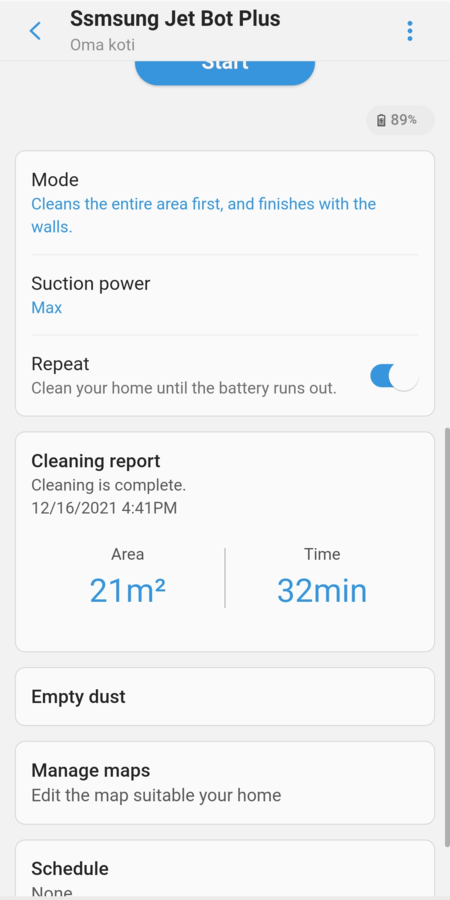
As a pleasant surprise, Samsung also allows quite easily to choose the tactics with which the robot will handle the cleaning. In our own tests, the best option turned out to be the choice where the vacuum first cleans the rooms and finally cleans the walls and the areas around the furniture.
Carpets are a traditional problem point for robot vacuum cleaners, and in Finland the situation is even more pronounced, as our culture prefers the most versatile carpets.
As a rule, the problem with some vacuums is not so much getting the carpets clean, but the fact that the robots manage to muck up the carpets and then get stuck in the pile of carpets they have caused themselves - and the cleaning stops there.
Samsung has solved the problem quite creatively: the Samsung Jet Bot 80 is very strong. Lighter carpets are very sensitive during cleaning, but Robo vacs don't care about the piles of carpets, but simply sweeps over them. Often, this brutal approach works amazingly well: going in one direction, the vacuum cleaner may crumple the carpet into a pile, but on the way back, calmly takes a bit of muscle from his back pocket and sweeps over the mountain of carpet - and may often straighten the carpets back on the floor.
In fact, during the entire test, the Samsung Jet Bot 80 never once got stuck on the mats, which is an extremely rare feat. Carpets were sometimes found in the strangest places and in the most unusual piles, but the Robo didn't get stuck in them.
Confusingly, the carpets were also clean: even though Samsung only has the peculiar solution of one soft cleaning roller, the robot's vacuuming power managed to keep the carpets clean throughout our test period. Especially when used regularly, about three times a week, the Samsung cleaner also kept the carpets in the pet-hosting household really clean.
As mentioned earlier, Samsung's engineers have decided to rely on brute force in the design of the vacuum cleaner, which is a confusingly-well-functioning solution.
When it comes to most obstacles and furniture, the vacuum knows how to dodge obstacles gracefully. In addition, the long side brush also enables a very precise cleaning result around table legs and other obstacles.
Samsung cleans the kitchen. The long video shows a couple of traditional robovacuum danger spots that Samsung manages to figure out
The Samsung Jet Bot 80 excelled especially with obstacles, which with many other vacuum cleaners is a hopeless endevour. Few robots can avoid chair legs that run flush with the floor - and neither can Samsung, but while the competitors get stuck in these difficult obstacles, the Samsung takes a vitamin pill from one of the corners of the battery cell and sweeps over the obstacles.
The Samsung Jet Bot 80+ can't handle everything, but even tested with the obstacles found to be the most difficult for robots, it cleared about 9 times out of ten, which is a truly respectable achievement for a robot that lacks obstacle avoidance based on artificial intelligence.
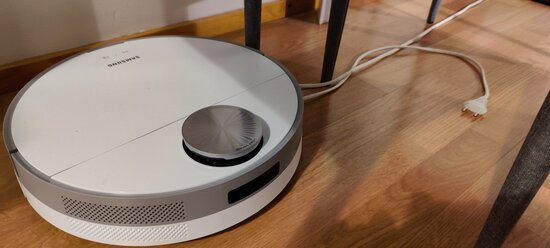
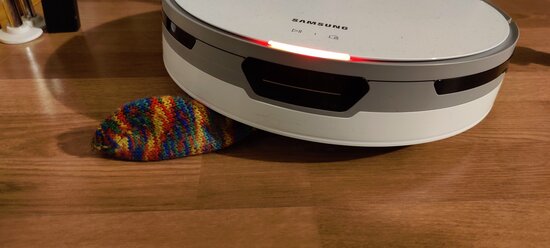
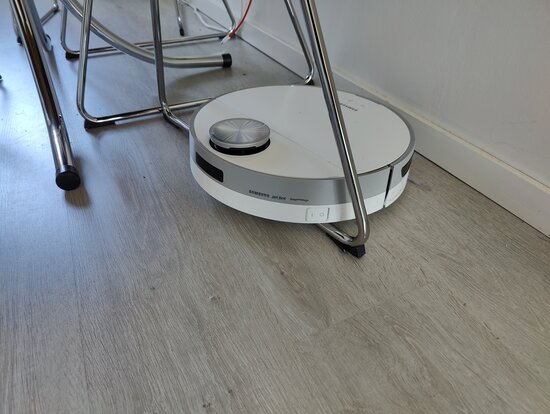
however, the Samsung Jet Bot 80+ did not always survive all obstacles, as the footage proves.
However, the lack of obstacle avoidance can be seen in certain obstacles: wires are poison for Samsung (and all other "basic" robots) and, as a rule, the jams observed during the test period were caused by power cords - or socks - that were just forgotten on the floor.
The sound produced by the Samsung during cleaning did not differ significantly from other powerful robot vacuum cleaners. In practice, the noise level was "annoying, but tolerable". However, we always recommend that the robot vacuum cleaners are scheduled to work when the apartment is empty, because the continuous annoying sound of vacuuming lasting an hour or two is not pleasant.
Samsung is emptying its own dustbin - and the noise is deafening
The Samsung is not a nuisance to the neighbors - except during self-emptying. As with many other self-emptying robot vacuum cleaners, the moment when the robot returns to its charging station to empty its internal dust container is quite deafening. Fortunately, the commotion only lasts for a little while.
Half of our test period was spent by the Samsung Jet Bot 80 in a pet-hosting household with both an angora-haired cat and cat litter spread around the apartment. The combination is a tough spot for many robots, because removing thin hair from carpets is a demanding job, and with cat litter, many robot vacuum cleaners are in really bad trouble.
But after a long test period, Samsung got full marks from the pet management point of view: when used regularly, Robo was able to keep the carpets hair-free throughout our test period. In addition, the vacuum cleaner received special praise for the smartly functioning combination of the side brush and the vacuum cleaner, thanks to which Samsung was able to clean all the cat litter off the floors with really good precision.
Naturally, self-emptying is also an almost mandatory feature for pet households. During our test period of several months, the dust bag of the charging dock did not have to be changed once - the traditional vacuum cleaner's dust container should have been emptied at least once a week at the pet destination.
Samsung's battery life is in the better middle class and is enough - a little depending on the settings and the home - to nicely clean an apartment of about 100m2 with one charge. In addition, the vacuum cleaner supports the so-called recharge and resume function, i.e. it can continue its cleaning from where it left off, if the battery had to be charged in the middle of cleaning.
Only fully charging the vacuum cleaner's battery, which takes almost 4 hours, is a clear weak link. In practice, during an 8-hour working day, the vacuum cleaner has time to completely clean about 200m2 of the apartment with one intermediate charge. However, the vacuum cleaner's granules are not enough to go beyond that, when charging takes such a long time.
The cleaning result was overall very good. The hard floor surfaces were cleaned by Jet Bot with very good, even excellent precision, and there was nothing to complain about in terms of the end result.
Even the corners and edges of the floor, the stumbling block of many robot vacuum cleaners, were taken very precisely by the Jet Bot: the reaching and well-designed side brush proved to be a clear advantage here.
As for carpets, the result was definitely a better middle class in that too. Only the threads and hairs embedded in the carpets sometimes seemed to cause a little difficulty for the robot's soft cleaning rollers. In this regard, silicone rollers, which e.g. Roomba uses, turned out to be a slightly better solution than Samsung's choice.
The Samsung Jet Bot 80+ proved to be a very pleasant acquaintance during our test period. It may not be the flashiest guy on the market, but in everything else it proved to be a very competent work animal.
Samsung's solution to deal with getting stuck in obstacles with brute force was the hilarious side of the vacuum cleaner - but at the same time it was also an ingenious choice on the part of the company. It was as if a tractor engine had been rammed into the robot, that's how efficiently Robo was able to get rid of all the problem areas.
The cleaning result was overall very good. Only when it comes to carpets, there are better solutions on the market, but Samsung was definitely not bad for them either - by no means.
In my opinion, the Samsung Jet Bot 80+ is definitely one of the best vacuum cleaners in its class: if you're looking for a great self-cleaning robot vacuum cleaner, but you don't want to invest a thousand euros in artificial intelligence-powered obstacle avoidance, Samsung is definitely an excellent choice.
The Samsung vacuum cleaner is also sold without a self-draining dock. The basic model, the Samsung Jet Bot 80, currently costs about 350 euros, so the price difference to the self-emptying model is about a hundred euros.
In other respects, the vacuum cleaners are identical to each other, but with a price difference of around 100, I personally would definitely lean towards the more expensive model equipped with a draining dock.
With a price tag of around 500 euros, Samsung places itself in a very competitive price category. But in the end, in the price range of around 500 euros, there aren't many self-emptying robot vacuum cleaners available, so if self-emptying is one of the selection criteria, the options are strangely limited. What makes the situation problematic is that in robovacuums, offers and sales often throw the prices quite strongly in one direction, if not the other.
If you are specifically looking for a self-cleaning alternative to Samsung in roughly the same price range, the Roomba i7+, which did a great job in our review and is sold for around 600-700 euros, and the Roomba i3+ , which costs around 500 euros, stand out.
Of these three, Jet Bot and i7+ clearly offer more functions, so for those who need more versatile functionality, the i3 is eliminated from the competition - although it is also an excellent vacuum cleaner.
Due to the price difference between the Roomba i7+ and Samsung, the scale easily tilts towards Samsung if price is a criterion. In this regard, however, it should be mentioned that between the two, Roomba is just a little bit better as a vacuum cleaner than Samsung - but you should watch the prices and consider based on that.
For many buyers, Samsung's clear disadvantage is that the robot's application has not been properly translated into Finnish and is otherwise confusing. So if English doesn't work, you should stick to the other options suggested here. In addition, the availability of Samsung spare parts on the shelf of a local electronics store can be a puzzle - just as spare parts for bigger brands, such as Roomba, can be found in practically all stores.
When it comes to stars, Samsung falls just short of perfect performance, even in its own price category. It is an excellent robot vacuum cleaner, but in this price range there are also slightly better carpet vacuuming devices available. In addition, the application's incomplete translation and general confusion lowers the grade by a hair.
Great buy anyway!
Written by Petteri Pyyny for fin.afterdawn.com, and translated by James Delahunty.
As usual, we put the robot to a work for more than three months. During our test period, the vacuum cleaner took care of cleaning the floor surfaces of two different apartments, as the only tool used for cleaning the floors.
Important to our test (as usual) is how suitable the product is for pet owners. Therefore, the test appropriately included everyday experience with how the Robo copes with pet hair and other problems that pets bring with them to the home.
The selling price for this product is around €500 in Finland, so it is placed in a difficult price segment in that sense: in the 500 euro range, top products are also available from competitors that manufacture robot vacuum cleaners, and they have more of a reputation in the market than Samsung.
- What is the Samsung Jet Bot 80+ like?
- Technical information
- Introduction
- Samsung SmartThings app
- Carpets
- Furniture and other obstacles
- Noise
- Pet economy
- Battery life and charging time
- Cleaning trace
- Summary
- Samsung Jet Bot 80 vs 80+
- Other options
- Pros
- Cons
- The stars
- More to read
What is the Samsung Jet Bot 80+ like?
The Samsung Jet Bot 80+ is delivered in a rather huge sales package typical of self-emptying robot vacuum cleaners.

The inside of the package reveals a shiny white robotic vacuum cleaner with a rather traditional design and a charging station that looks like a futuristic coffee maker. The charging station contains a mechanism with which the actual robot vacuum can empty its internal dust container into the larger dust container located in the charging dock.

The robot itself is clear and simple: a disc with two tactile buttons on top.

The most clearly distinguishing detail in the appearance is the lidar radar of the Samsung Jet Bot 80+, left in chrome, which rises about a centimeter above the rest of the body.

Samsung's interesting solution is revealed below: instead of brush rollers or silicone rollers, Samsung relies on a single, soft cleaning roller that resembles a rough sponge. At this point it should be mentioned that Jet Bot is not a robot mop.
The robot's side brush is commendably large and clearly protrudes, which promises good things when it comes to cleaning corners and walls.

The tower of the charging dock features a container that opens with a clever mechanism, inside of which there is space for Samsung's own dust bags. The dust bags are a little disappointing, but for some reason almost all manufacturers prefer dust bags in the docks of self-cleaning robots. However, a large container that can be knocked empty would be a more ecologically sound choice.
Technical information
| Internal dust container | 0.3 liters |
| Clean Station - dustbag size | 2.5 liters |
| Dimensions | 35 cm (round) x 9.9 cm (height) |
| Weight | 3.81 kg |
| Battery life | 90 minutes |
| Loading time | 240 minutes |
| Change | Practically requires a WiFi network at home; no-go areas, room-specific cleaning; washable internal dust container; self-emptying |
| Price | Around 500 euros |
Introduction
The Samsung Jet Bot 80+ is very clearly a "connected" device, meaning that in practice the full use of the vacuum cleaner requires that there is WiFi and a smartphone at home. All adjustment of the robot and general control takes place through the smartphone application.
Using the robot is very clear in itself: let's find a suitable place for it, from where the vacuum cleaner can move freely in all situations throughout the apartment. Place the Clean Station charging dock in the selected location and start charging the robot.

After that, install the Samsung SmartThings application and connect the robot to the application. Finally, let the robot do a mapping tour of the apartment, during which the robot builds a floor plan of the apartment with the continuation in mind.
Samsung SmartThings app
Samsung's SmartThings application is in many ways an excellent package, but can also be confusing. The application is not only intended for controlling the robot vacuum cleaner, rather the application is the common "home" of all Samsung smart devices, through which all Samsung devices are controlled.
The starting point is clever in itself, but if the robot vacuum cleaner is the only Samsung smart device in the home, the application is extremely versatile. In addition, a big minus comes from the fact that Samsung SmartThings is only partially translated - the functions related to the robot vacuum are left completely untranslated - even though the main application itself is reasonably well translated.
When you dig into the settings and functions of the robot vacuum cleaner in the application, that side is relatively clearly designed. Roughly, you could say that if Roomba's application is the clearest on the market and Xiaomi's / Roborock's alternative is the most confusing, Samsung is somewhere in between.

However, the robot can be controlled very well through the application. Creating schedules is simple, but also the construction of complex logical functions focused on the smart home can be done after a little thought.


When it comes to maps, Samsung is right at the top of the robot vacuum cleaners: editing maps, dividing into rooms, creating prohibited areas and building separate cleaning areas are all very easy.

Also, a real-time image of where the robot is cleaning in the apartment at that moment is a handy addition. From the same view, you can also get an idea of which part of the apartment the robot has already managed to clean.

As a pleasant surprise, Samsung also allows quite easily to choose the tactics with which the robot will handle the cleaning. In our own tests, the best option turned out to be the choice where the vacuum first cleans the rooms and finally cleans the walls and the areas around the furniture.
Carpets
Carpets are a traditional problem point for robot vacuum cleaners, and in Finland the situation is even more pronounced, as our culture prefers the most versatile carpets.
As a rule, the problem with some vacuums is not so much getting the carpets clean, but the fact that the robots manage to muck up the carpets and then get stuck in the pile of carpets they have caused themselves - and the cleaning stops there.
Samsung has solved the problem quite creatively: the Samsung Jet Bot 80 is very strong. Lighter carpets are very sensitive during cleaning, but Robo vacs don't care about the piles of carpets, but simply sweeps over them. Often, this brutal approach works amazingly well: going in one direction, the vacuum cleaner may crumple the carpet into a pile, but on the way back, calmly takes a bit of muscle from his back pocket and sweeps over the mountain of carpet - and may often straighten the carpets back on the floor.
In fact, during the entire test, the Samsung Jet Bot 80 never once got stuck on the mats, which is an extremely rare feat. Carpets were sometimes found in the strangest places and in the most unusual piles, but the Robo didn't get stuck in them.
Confusingly, the carpets were also clean: even though Samsung only has the peculiar solution of one soft cleaning roller, the robot's vacuuming power managed to keep the carpets clean throughout our test period. Especially when used regularly, about three times a week, the Samsung cleaner also kept the carpets in the pet-hosting household really clean.
Furniture and other obstacles
As mentioned earlier, Samsung's engineers have decided to rely on brute force in the design of the vacuum cleaner, which is a confusingly-well-functioning solution.
When it comes to most obstacles and furniture, the vacuum knows how to dodge obstacles gracefully. In addition, the long side brush also enables a very precise cleaning result around table legs and other obstacles.
Samsung cleans the kitchen. The long video shows a couple of traditional robovacuum danger spots that Samsung manages to figure out
The Samsung Jet Bot 80 excelled especially with obstacles, which with many other vacuum cleaners is a hopeless endevour. Few robots can avoid chair legs that run flush with the floor - and neither can Samsung, but while the competitors get stuck in these difficult obstacles, the Samsung takes a vitamin pill from one of the corners of the battery cell and sweeps over the obstacles.
The Samsung Jet Bot 80+ can't handle everything, but even tested with the obstacles found to be the most difficult for robots, it cleared about 9 times out of ten, which is a truly respectable achievement for a robot that lacks obstacle avoidance based on artificial intelligence.



however, the Samsung Jet Bot 80+ did not always survive all obstacles, as the footage proves.
However, the lack of obstacle avoidance can be seen in certain obstacles: wires are poison for Samsung (and all other "basic" robots) and, as a rule, the jams observed during the test period were caused by power cords - or socks - that were just forgotten on the floor.
Noise
The sound produced by the Samsung during cleaning did not differ significantly from other powerful robot vacuum cleaners. In practice, the noise level was "annoying, but tolerable". However, we always recommend that the robot vacuum cleaners are scheduled to work when the apartment is empty, because the continuous annoying sound of vacuuming lasting an hour or two is not pleasant.
Samsung is emptying its own dustbin - and the noise is deafening
The Samsung is not a nuisance to the neighbors - except during self-emptying. As with many other self-emptying robot vacuum cleaners, the moment when the robot returns to its charging station to empty its internal dust container is quite deafening. Fortunately, the commotion only lasts for a little while.
Pet household
Half of our test period was spent by the Samsung Jet Bot 80 in a pet-hosting household with both an angora-haired cat and cat litter spread around the apartment. The combination is a tough spot for many robots, because removing thin hair from carpets is a demanding job, and with cat litter, many robot vacuum cleaners are in really bad trouble.
But after a long test period, Samsung got full marks from the pet management point of view: when used regularly, Robo was able to keep the carpets hair-free throughout our test period. In addition, the vacuum cleaner received special praise for the smartly functioning combination of the side brush and the vacuum cleaner, thanks to which Samsung was able to clean all the cat litter off the floors with really good precision.
Naturally, self-emptying is also an almost mandatory feature for pet households. During our test period of several months, the dust bag of the charging dock did not have to be changed once - the traditional vacuum cleaner's dust container should have been emptied at least once a week at the pet destination.
Battery life and charging time
Samsung's battery life is in the better middle class and is enough - a little depending on the settings and the home - to nicely clean an apartment of about 100m2 with one charge. In addition, the vacuum cleaner supports the so-called recharge and resume function, i.e. it can continue its cleaning from where it left off, if the battery had to be charged in the middle of cleaning.
Only fully charging the vacuum cleaner's battery, which takes almost 4 hours, is a clear weak link. In practice, during an 8-hour working day, the vacuum cleaner has time to completely clean about 200m2 of the apartment with one intermediate charge. However, the vacuum cleaner's granules are not enough to go beyond that, when charging takes such a long time.
Cleaning trace
The cleaning result was overall very good. The hard floor surfaces were cleaned by Jet Bot with very good, even excellent precision, and there was nothing to complain about in terms of the end result.
Even the corners and edges of the floor, the stumbling block of many robot vacuum cleaners, were taken very precisely by the Jet Bot: the reaching and well-designed side brush proved to be a clear advantage here.
As for carpets, the result was definitely a better middle class in that too. Only the threads and hairs embedded in the carpets sometimes seemed to cause a little difficulty for the robot's soft cleaning rollers. In this regard, silicone rollers, which e.g. Roomba uses, turned out to be a slightly better solution than Samsung's choice.
Summary
The Samsung Jet Bot 80+ proved to be a very pleasant acquaintance during our test period. It may not be the flashiest guy on the market, but in everything else it proved to be a very competent work animal.
Samsung's solution to deal with getting stuck in obstacles with brute force was the hilarious side of the vacuum cleaner - but at the same time it was also an ingenious choice on the part of the company. It was as if a tractor engine had been rammed into the robot, that's how efficiently Robo was able to get rid of all the problem areas.
The cleaning result was overall very good. Only when it comes to carpets, there are better solutions on the market, but Samsung was definitely not bad for them either - by no means.
In my opinion, the Samsung Jet Bot 80+ is definitely one of the best vacuum cleaners in its class: if you're looking for a great self-cleaning robot vacuum cleaner, but you don't want to invest a thousand euros in artificial intelligence-powered obstacle avoidance, Samsung is definitely an excellent choice.
Samsung Jet Bot 80 vs 80+
The Samsung vacuum cleaner is also sold without a self-draining dock. The basic model, the Samsung Jet Bot 80, currently costs about 350 euros, so the price difference to the self-emptying model is about a hundred euros.
In other respects, the vacuum cleaners are identical to each other, but with a price difference of around 100, I personally would definitely lean towards the more expensive model equipped with a draining dock.
Other options
With a price tag of around 500 euros, Samsung places itself in a very competitive price category. But in the end, in the price range of around 500 euros, there aren't many self-emptying robot vacuum cleaners available, so if self-emptying is one of the selection criteria, the options are strangely limited. What makes the situation problematic is that in robovacuums, offers and sales often throw the prices quite strongly in one direction, if not the other.
If you are specifically looking for a self-cleaning alternative to Samsung in roughly the same price range, the Roomba i7+, which did a great job in our review and is sold for around 600-700 euros, and the Roomba i3+ , which costs around 500 euros, stand out.
Of these three, Jet Bot and i7+ clearly offer more functions, so for those who need more versatile functionality, the i3 is eliminated from the competition - although it is also an excellent vacuum cleaner.
Due to the price difference between the Roomba i7+ and Samsung, the scale easily tilts towards Samsung if price is a criterion. In this regard, however, it should be mentioned that between the two, Roomba is just a little bit better as a vacuum cleaner than Samsung - but you should watch the prices and consider based on that.
For many buyers, Samsung's clear disadvantage is that the robot's application has not been properly translated into Finnish and is otherwise confusing. So if English doesn't work, you should stick to the other options suggested here. In addition, the availability of Samsung spare parts on the shelf of a local electronics store can be a puzzle - just as spare parts for bigger brands, such as Roomba, can be found in practically all stores.
Pros
- very good cleaning result
- excellent self-emptying
- great map functions
- doesn't get caught up in obstacles much
Cons
- slow loading
- application only partially in Finnish
- availability of spare parts (at least for now) weaker than big robo brands
Rating
When it comes to stars, Samsung falls just short of perfect performance, even in its own price category. It is an excellent robot vacuum cleaner, but in this price range there are also slightly better carpet vacuuming devices available. In addition, the application's incomplete translation and general confusion lowers the grade by a hair.
Great buy anyway!
Written by Petteri Pyyny for fin.afterdawn.com, and translated by James Delahunty.














